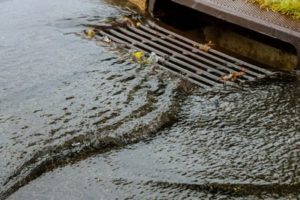
How does it work? A storm drainage system consists of several main parts.
Maryland has no lack of water, with plenty of rivers and rainfall every year. While rain is certainly good, an excess of it can cause problems. This excess rainfall is called stormwater, and every county is responsible for stormwater management, the process of allowing it to seep into the soil or run back into a natural body of water. Sometimes, your public county or private business storm drainage system will require maintenance. To help make this process easier to manage, here are some industry terms to make things clearer.
Inlets
Storm drain inlets are the openings that allow stormwater to flow into a storm drainage system. There are many types of inlets, including:
- Curb opening inlet: A long, narrow, horizontal opening at the edge of a curb.
- Grate inlet: A grate covering to a drain at the low point of a road, swale, or another drainage site.
- Drop inlet: A horizontal or near-horizontal opening.
- Slotted drain inlet: A grate inserted into the top of a stormwater drain pipe.
- Combination inlet: Usually a combination of a curb opening inlet with a grate inlet, although other combinations are possible.
- Flanking inlets: Two inlets positioned opposite one another upstream of an inlet at a low point. This pair helps to intercept debris and relieve the low point inlet.
Storm Drains
A popular term you might hear is a “stormwater catch basin” or just a “catch basin.” This device is a basin that collects water and lets it out through a narrow pipe when the water reaches a certain level. While catch basins are popular for landscape drainage, a storm drain is a type of catch basin, allowing stormwater to flow into it through a stormwater inlet.
Culverts
Culverts are massive pipes that carry stormwater underground to a local pond, treatment plant, or another destination. They are handy for allowing the water to flow under roads, railroads, and other surface-level constructions. A culvert might have one or two inlets connected to each section.
Manholes
What are manholes for, anyway? Some manholes, also known as access holes, are points at which maintenance crew such as Jet Blast Inc. can clean, repair, and maintain the storm drain system without having to go into it themselves.
Trunk Line
The trunk line, or “main,” is the main pipeline that carries the stormwater away. The storm drain will lead water into this system, which flows at a steady rate and takes in a steady amount to prevent a surcharge.
Contact Jet Blast Inc. Today!
Jet Blast® Industrial Services strives every day in an effort to provide our customers with the best service and equipment possible. Providing a safe and stable workplace has allowed us to keep a team of quality people with most having a tenure of 15 – 25 years with Jet Blast®. With all that experience under one roof, we have been able to provide reliable 24-hour service for over 42 years. I believe this helps to set us apart from the competition.
Compare us! Let us make your job easier. If you’re located in Maryland, Pennsylvania, Delaware, Northern Virginia, or Washington, D.C., contact us by email at [email protected], call us at 410-636-0730, or fax us at 410-789-3907, and don’t forget to keep in touch with us on Facebook!
